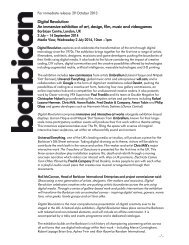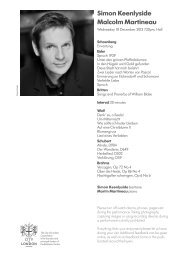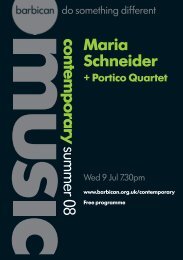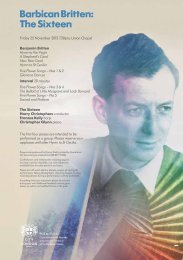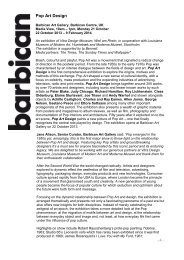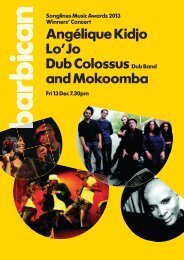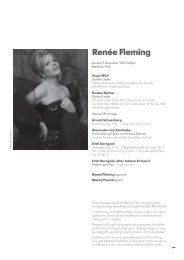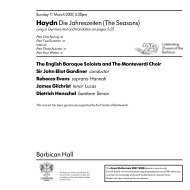Download your concert programme here - Barbican
Download your concert programme here - Barbican
Download your concert programme here - Barbican
Create successful ePaper yourself
Turn your PDF publications into a flip-book with our unique Google optimized e-Paper software.
Thursday 4 February<br />
Joseph Haydn (1732–1809)<br />
Symphony No. 49 in F minor, ‘La Passione’, Hob. I:49 (1768)<br />
1 Adagio<br />
2 Allegro di molto<br />
3 Menuet<br />
4 Finale: Presto<br />
Dated 1768, ‘La Passione’ is one of the most famous of a<br />
whole series of minor-mode Haydn symphonies from around<br />
1770. Some commentators have postulated – with no<br />
biographical evidence – that this outbreak of minor-key<br />
angst was prompted by a ‘romantic crisis’. In any case,<br />
Haydn was the least confessional of composers. Far more<br />
convincing is the notion that, like other composers, including<br />
J. B. Vanhal, Carlo d’Ordoñez (Austrian, despite his name)<br />
and the teenage Mozart (in his ‘little’ G minor Symphony,<br />
K183), Haydn was eager to explore the potential for tragic or<br />
stormy expression in a symphonic language that, thanks<br />
above all to Haydn himself, was rapidly developing in<br />
complexity and expressive power. This proliferation of minorkey<br />
symphonies has spawned the term Sturm und Drang<br />
(literally ‘Storm and Surge’, but more commonly rendered as<br />
‘Storm and Stress’), after a blood-and-thunder play on the<br />
American Revolution by Maximilian Klinger – a convenient<br />
enough stylistic label, though the official Sturm und Drang<br />
literary movement, kickstarted by Goethe’s rampaging 1773<br />
drama Götz von Berlichingen and his sensational novel Die<br />
Leiden des jungen Werther, lay in the future.<br />
‘La Passione’ is the last of Haydn’s symphonies to adopt the<br />
old sonata da chiesa (church sonata) pattern – ie, beginning<br />
with a slow movement. It is also his only symphony to retain<br />
the minor mode for each of the four movements; this,<br />
together with its lean, acerbic orchestral palette (strings plus<br />
oboes and horns, the latter used as a sombre or ominous<br />
backdrop), gives the work an almost unremitting bleakness.<br />
As with so many Haydn symphonies, the origins of the<br />
nickname are obscure, though one story has it that the work<br />
was first performed on Good Friday in the Esterházys’<br />
Eisenstadt palace. Certainly, the title fits the opening Adagio,<br />
with its mournful, burdened tread evocative of the via crucis.<br />
The initial motif (C–D flat–B flat–C) pervades each of the four<br />
movements, a pointer to Haydn’s growing interest in cyclic<br />
integration. The unexpected entry of the recapitulation,<br />
quietly reasserting F minor when the preceding bar led us to<br />
expect a chord of C minor, is paralleled by the underprepared<br />
recapitulations in both the second movement and<br />
the finale – all instances of Haydn’s sophisticated and (<strong>here</strong>)<br />
disquieting play with his listeners’ expectations.<br />
In the hectic, angular Allegro di molto, even more than in the<br />
Adagio, thematic development and variation spill far beyond<br />
the so-called ‘development’; as so often with Haydn, the<br />
recapitulation is not so much a restatement as a fiercely<br />
compressed reinterpretation of earlier events. The gravely<br />
beautiful Menuet has its own formal surprise in the 12-bar<br />
coda, which introduces a new sighing figure that deepens the<br />
mood of sorrowful resignation. By contrast, the trio, with its<br />
gleaming high horns, provides the one point of repose – and<br />
the sole appearance of F major – in the whole symphony.<br />
The driving, desperate finale revives the second movement’s<br />
Sturm und Drang with a laconic explosiveness of its own.<br />
Programme note © Richard Wigmore<br />
8




